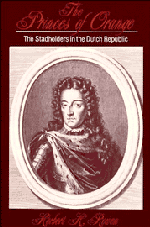Book contents
- Frontmatter
- Contents
- List of illustrations
- Preface
- Prologue: lieutenants of the crown
- 1 William I: from courtier to rebel
- 2 Maurice of Nassau: defender of the Republic
- 3 Frederick Henry: firm in moderation
- 4 William II: the challenger
- 5 The first stadholderless period: 1 exclusion
- 6 The first stadholderless period: 2 return
- 7 William III: stadholder and king
- 8 The second stadholderless period: doldrums
- 9 William IV: neither revolutionary nor reformer
- 10 William V: the era of Anna and Brunswick
- 11 William V: the Patriot challenge
- Epilogue: consequences and conclusions
- Bibliography
- Index
- Title in series
Prologue: lieutenants of the crown
Published online by Cambridge University Press: 01 June 2011
- Frontmatter
- Contents
- List of illustrations
- Preface
- Prologue: lieutenants of the crown
- 1 William I: from courtier to rebel
- 2 Maurice of Nassau: defender of the Republic
- 3 Frederick Henry: firm in moderation
- 4 William II: the challenger
- 5 The first stadholderless period: 1 exclusion
- 6 The first stadholderless period: 2 return
- 7 William III: stadholder and king
- 8 The second stadholderless period: doldrums
- 9 William IV: neither revolutionary nor reformer
- 10 William V: the era of Anna and Brunswick
- 11 William V: the Patriot challenge
- Epilogue: consequences and conclusions
- Bibliography
- Index
- Title in series
Summary
Like the Dutch Republic itself, the stadholderate was an improvisation. Both were old structures adapted to new needs and a new situation, the product of the peculiar course of the Revolt of the Low Countries. The Republic of the United Provinces of the Netherlands was a rump remnant of the “Burgundian state,” as historians call the assemblage of lands under the rule of the French dukes of Burgundy since the late fourteenth century. But it was more than a rump; it had become a new nation, a new state, in which the stadholderate changed character.
The core of “Burgundy” was neither the duchy of Burgundy within France itself nor the adjacent “Free County” (Franche-Comté) of the same name within the Empire, but the seventeen provinces that straddled the delta of the merged Rhine, Maas (Meuse) and Schelde (Scheldt) Rivers as they flowed into the North Sea. They had never formed a unified state in the modern sense, such as France and England had already become, but were little more than a congeries of lands acquired by the Burgundian dukes beginning in the late fourteenth century and by their heirs, the Habsburgs of Austria and Spain, in the first half of the sixteenth. Their unity consisted essentially in shared rulership and the single policy which their resources served. Because the revenues of the dukes, fed by the fabulous industry, trade and agriculture of the Low Countries, were immense, the “Burgundian state” was one of the great powers of the fifteenth century.
- Type
- Chapter
- Information
- The Princes of OrangeThe Stadholders in the Dutch Republic, pp. 1 - 7Publisher: Cambridge University PressPrint publication year: 1988

